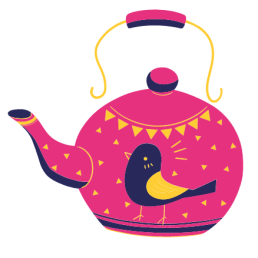
Buongiorno a tutti!
So, I’m back in the UK, and I’ve had a chance to think about my time in Italy. Today I’ll be talking about one really *memorable moment: teaching a 23-year-old Italian man how to turn a kettle on!
I already knew that kettles weren’t common in Italian homes, but I hadn’t realised just how alien the idea of a kettle is to Italians.
So, why do we use kettles and Italians don’t? I decided to do some research into the *origins of the kettle to find out!

First of all, the word ‘kettle’ comes from the Old English* word ‘cetil’, and it can be traced all the way back to the Latin word ‘catillus’, meaning a ‘deep pan or dish for cooking’ (OED, 2022).
There is evidence that kettles were being used, even before the word itself was created! For example, *archaeologists have found a bronze vessel* used to boil water that dates back to *3000BC!
Different sorts of kettles became popular in different places around the world as water was boiled to make it clean. Iron kettles were most common as travellers, soldiers and families would use these to cook food and boil water (Aqua Libra, 2020).
However, in *Ancient China, people would improve the flavour of water by adding tea leaves, which resulted in the creation of tea!
As this tradition became more common in Chinese culture, porcelain* kettles were made specifically to make tea with (In The Kitchen, 2017).
The British were influenced by these traditions and our love for the kettle comes from our *obsession with tea.
When tea was first brought to Britain from Asia in the 17th century, it was only drunk by the richest people in society. But, as time went on, tea became more available, and so did the equipment used to make it. So, by the late 18th century, copper kettles had started to appear in British homes.
In the 20th century, the stovetop kettle arrived in British homes, along with the whistling kettle, which would let out a *piercing noise to let you know that the water had boiled! Eventually, these kettles were replaced by the modern electric kettle, which is what most of us use today.
So why didn’t kettles become popular in Italy? Because tea itself never became popular!
Italians love coffee and coffee culture, which has grown more and more popular ever since coffee first arrived in Venice in the 17thcentury.
At the start of the 20th century, the strong coffee known as espresso was invented in Milan, which lead to the creation of the first coffee bars that you can now find all over Italy (Neighbourhood Coffee Roasters, 2022).

So, while we Brits were boiling water for tea in kettles, Italians were making strong coffee in moka pots*, which could be used on a stovetop much like a traditional kettle in the UK.
A kettle may be a rare sight in Italy, but I’ve yet to visit an Italian home without a moka pot or an espresso machine.
With all this in mind, should I really be surprised that a fully-grown Italian man could not work an electric kettle? Let me know your thoughts in the comments.
Vocabluary:
- Memorable: something that’s easy to remember because it is/was special or unusual
- Origins: where something comes from
- Old English: The earliest recorded form of English, used up until around 1150
- Archaeologists: someone who studies history by digging up and studying remains
- Vessel: A container, especially one used to hold liquid
- BC: Before Christ
- Ancient China: A very old civilisation
- Obsession: when something or someone is always on your mind
- Piercing: very loud
- Porcelain: More commonly known as ‘china’, named after where it originated
- Moka pot: A stove-top coffee maker, invented in Italy (https://en.wikipedia.org/wiki/Moka_pot)
